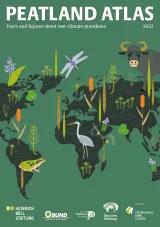
Few peatlands in Europe are located within protected areas, and even there, they are not always protected adequately. National agricultural policies provide little or no support for the development of sustainable peatland-management practices.

Peatlands can be found in all countries in Europe except Malta. They are concentrated in northwestern and eastern Europe and in the Nordic countries. In southern Europe, peatlands are less common. Areas with a natural surface peat layer more than 30 cm thick cover almost 59 million hectares in Europe, this equals 12 percent of the world’s peatlands. If shallower peatlands are included, the total area is 100 million hectares, or about 10 percent of the total surface area. Europe’s main mire regions vary substantially in size, mire diversity, peatland condition and protection. Throughout Europe, only 16 percent of the peatland area is located within protected areas, and often this does not equal adequate protection.
The largest peatlands in Europe are a 178,000-hectare mire named Ocean in the Republic of Komi, and the 96,000-hectare Polisto-Lovatsky mire in Pskov Oblast in western Russia. The smallest peatlands are located in the highlands and steppes and cover only a few square metres. Across Europe, the average depth of peat is 3 to 4 metres, with maximum depths typically 10 to 12 metres. The deepest peatland in Europe can be found in northern Greece at up to 190 metres: The Philippi peatland. This area provides a unique opportunity to study the transition from peat to coal at a depth of around 120 m.
The EU’s European Red List of Habitats, which covers the EU, the rest of western Europe and the Balkans, includes 13 treeless peatland habitats, three of which are considered as vulnerable and one as critically endangered. Including non-EU countries in eastern Europe would result in a different list of rare peatland habitats. Bogs and spruce-dominated peatlands are not endangered in the Carpathians and Urals or in the Russian part of the East European Plain.
Mire landscapes often include rather few species, but highly specialised ones. The proportion of endangered species in peatlands is often higher than in other ecosystems. The IUCN’s Red List of Threatened Species includes nine European vascular plants and five types of birds. Important umbrella or flagship species in European fens are the aquatic warbler, the fen orchid and for bogs the golden plover and the wood sandpiper.
Europe has a long history of peatland use and degradation. Human impacts have included using peatlands for food, fodder, fibre and fuel, and draining them for intensive agriculture, forestry and peat extraction. Peatlands have also been used for urban, industrial and infrastructural development. More recently, large areas of peatland have been cleared to make way for water reservoirs or windmills to generate electricity. Human impact has also been indirect. For example, as early as 3,000 years ago, the anthropogenic deforestation of upland areas led to changes in the flow of rivers and the consequent widening of estuaries, resulting in massive peatland erosion in the perimarine floodplains of the Netherlands. However, human activities have also led to the creation and expansion of peatlands in Europe through interference with landscape hydrology. In oceanic parts of the continent, blanket bogs have formed as a result of land clearing, burning and livestock grazing. Such blanket bogs often occur in mosaics with heathlands that were established some 3,000 to 4,000 years ago.
Europe is the continent with the largest proportional loss of actively accumulating peatlands, due to its long history, high population pressure and climatic suitability for agriculture as the main driver of peatland drainage. As peat extraction and human-induced oxidation and erosion have transformed many former peatlands into mineral soils, about 10 percent of the maximum peatland area during the Holocene (the period since the last ice age, 10,700 years ago) no longer exists as peatland. Nineteen European countries each have more than 100,000 hectares of severely degraded peatlands. In Finland, nearly 60 percent of the peatland area was destroyed during Europe’s most ambitious peatland drainage programme, especially in the 1970s, when about 300,000 hectares were drained each year. In countries such as the Netherlands, not a single peatland has been left untouched, and only a very small remnant of peatland remains undrained. Nevertheless, Europe still has a significant diversity of mires, which are often the last wilderness areas in a predominantly cultivated landscape.
The high degree degradation makes Europe the world’s second largest emitter of greenhouse gases from drained peatlands, after Indonesia. The climate crisis is also causing peat loss from undrained peatlands as a result of prolonged droughts and heatwaves, fires, vegetation change and permafrost degradation. Large and rapid losses of ancient permafrost carbon have only recently begun and will increase in the future, according to studies.
Problems associated with unsustainable peatland management, including drainage for agriculture and forestry, have not been fully addressed in land use and climate policies in Europe. Furthermore, EU and national agricultural policies, with their established subsidy systems, do not or only little support the development of sustainable peatland management practices. As a result, the problems associated with peatland drainage in Europe are far from being solved. The continent lags far behind Indonesia – a country that has already rewetted more than 20 times the area that Europe has rewetted in its entire history.

